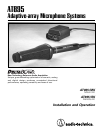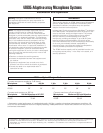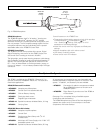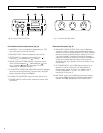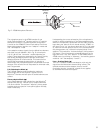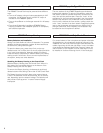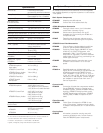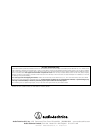
2
AT895 Adaptive-array Microphone Systems
Installation and Operation
Note: This equipment has been tested and found to
comply with the limits for a Class B digital device,
pursuant to Part 15 of the FCC rules. These limits are
designed to provide reasonable protection against harmful
interference in a residential installation. This equipment
generates, uses, and can radiate radio frequency energy
and, if not installed and used in accordance with the
instructions, may cause harmful interference to radio
communications. However, there is no guarantee that
interference will not occur in a particular installation. If
this equipment does cause harmful interference to radio
or television reception, which can be determined by
turning the equipment off and on, the user is encouraged
to try to correct the interference by one or more of the
following measures:
• Reorient or relocate the receiving antenna.
• Increase the separation between the equipment and
the receiver.
• Connect the equipment into an outlet on a circuit
different from that to which the receiver is connected.
• Consult the dealer or an experienced radio TV
technician for help.
Incorporated in the AT895 design are: DSDA-PRO
™
software (U.S. Patent No. 5,825,898) by Lamar Signal Processing, Ltd., a wholly-owned
subsidiary of Andrea Electronics Corporation; DeltaBeam
™
(U.S. Patent pending) and MicroLine
®
technologies by Audio-Technica.
“DSDA-PRO” is a trademark of Lamar Signal Processing, Ltd.; “DeltaBeam” is a trademark of and “MicroLine” is a registered trademark
of Audio-Technica.
Introduction
Thank you for choosing an AT895 Adaptive-array Microphone
System. AT895 Systems incorporate a revolutionary DSP-
controlled five-element microphone array that provides
adaptive directional audio acquisition.
Utilizing Audio-Technica’s proprietary DeltaBeam
™
technology,
the AT895 System manipulates and filters the output of the
array by acoustical, analog and digital means. This process
enhances the pickup of a sound source from a desired
direction relative to unwanted background noise or
interference, providing cancellation of up to 80 dB. Other
benefits include minimized audibility of proximity effect,
minimized nearfield effect on the low-frequency directionality
of the array, and markedly reduced susceptibility to
mechanical noise, wind noise and racking as compared to
currently-available professional microphones.
The AT895 functions equally well for handheld interview use
or long-range sound pickup – in the field, in the studio, or in
security operations.
Warning: Changes or modifications to this unit
not expressly approved by the party responsible for
compliance could void the user’s authority to operate
the equipment.
Compare acceptance angles (at 3 dB down):
Microphone 200 Hz 400 Hz 1 kHz 2 kHz 4 kHz 8 kHz
Shotgun 60˚ 60˚ 60˚ 50˚ 30˚ 20˚
AT895 20˚ 20˚ 20˚ 20˚ 60˚ 50˚
Compare polar patterns at 200 Hz:
Microphone 200 Hz Rejection at 90˚/270˚
Shotgun 15 dB
AT895 70 dB
Compare maximum off-axis rejection:
Microphone Maximum Off-axis Rejection
Shotgun 30 dB
AT895 80 dB
AT895 vs. Typical Shotgun Performance
†
†
Compared to typical performance of a professional-quality 15.5" line + gradient microphone (measurement conditions: 1Pa
at 0.5 m). Due to the adaptive nature of its digital processing, AT895 performance in actual field conditions will vary with the
environment encountered.



